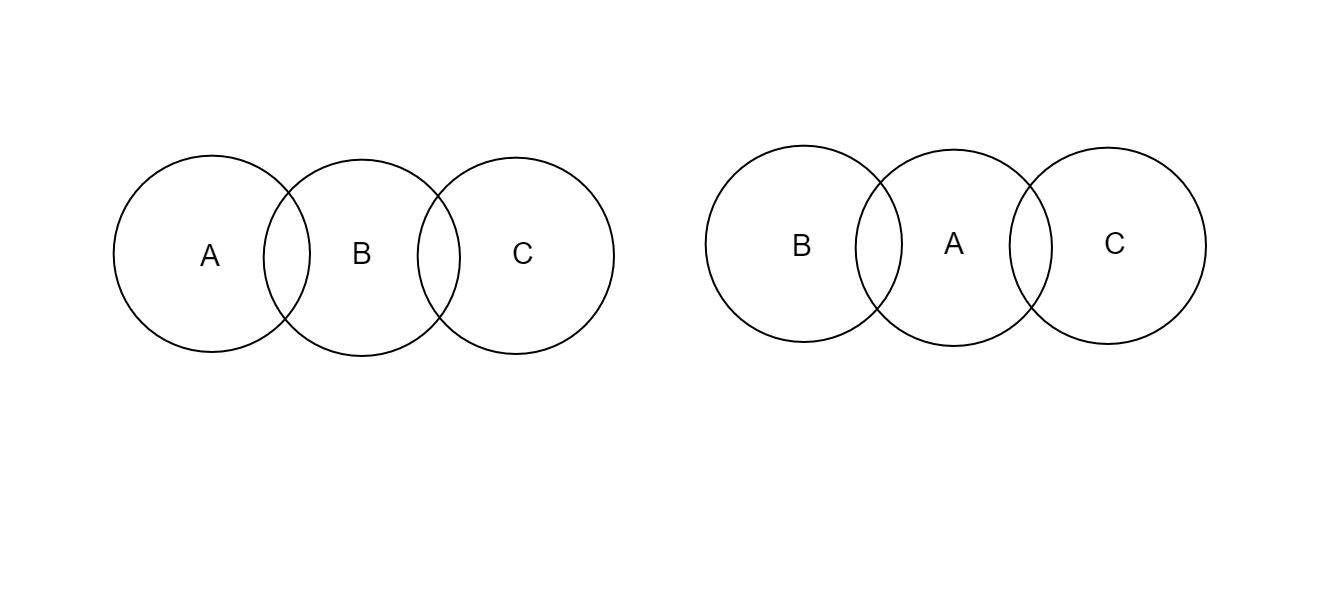
In a school, there are $3$ types of games to be played. Some of the students play $2$ types of games, but none play all $3$ games. Which Venn diagrams can justify the above statements?

1. P and R
2. P and Q
3. None of these
4. Q and R
Answer
215.7k+ views
Hint: Here, we are given three Venn diagrams P, Q, and R. We have to select which of the diagram justifies the statement that some students play two games, but none plays all three games. It means, we have to check which of the diagram is not of intersection.
Formula Used:
Given Venn diagram are of intersection i.e., $A \cap B \cap C$
Complete step by step Solution:
Let, A, B, and C be the first, second, and third games that are played by the student in school
Now, let the condition be some students play two games, but none play all three games.
It means, in the Venn diagram there should be no common part in all three games.
There should be a common part in any of the two games,
Case 1: A and B
Case 2: B and C
Case 3: A and C
A Venn diagram of the given statement is attached below,
 Now, in the given Venn diagram P, Q, and R, there are common parts in all three games. This implies that there are some students who play all three games which contradicts the statement that none of the students plays all three games.
Now, in the given Venn diagram P, Q, and R, there are common parts in all three games. This implies that there are some students who play all three games which contradicts the statement that none of the students plays all three games.
Hence, the correct option is 3.
Note: The key concept involved in solving this problem is a good knowledge of Union and Intersection. Students must know that the union of two sets P and Q corresponds to the set of elements that are included in set P, set Q, or both sets P and Q. The intersection of two subsets of the universal set U, A, and B, is the set that contains all of the elements that are shared by both A and B.
Formula Used:
Given Venn diagram are of intersection i.e., $A \cap B \cap C$
Complete step by step Solution:
Let, A, B, and C be the first, second, and third games that are played by the student in school
Now, let the condition be some students play two games, but none play all three games.
It means, in the Venn diagram there should be no common part in all three games.
There should be a common part in any of the two games,
Case 1: A and B
Case 2: B and C
Case 3: A and C
A Venn diagram of the given statement is attached below,
 Now, in the given Venn diagram P, Q, and R, there are common parts in all three games. This implies that there are some students who play all three games which contradicts the statement that none of the students plays all three games.
Now, in the given Venn diagram P, Q, and R, there are common parts in all three games. This implies that there are some students who play all three games which contradicts the statement that none of the students plays all three games.Hence, the correct option is 3.
Note: The key concept involved in solving this problem is a good knowledge of Union and Intersection. Students must know that the union of two sets P and Q corresponds to the set of elements that are included in set P, set Q, or both sets P and Q. The intersection of two subsets of the universal set U, A, and B, is the set that contains all of the elements that are shared by both A and B.
Recently Updated Pages
Alpha, Beta, and Gamma Decay Explained

Alpha Particle Scattering and Rutherford Model Explained

Angular Momentum of a Rotating Body: Definition & Formula

Apparent Frequency Explained: Formula, Uses & Examples

Applications of Echo in Daily Life and Science

Average and RMS Value Explained: Formulas & Examples

Trending doubts
JEE Main 2026: Application Form Open, Exam Dates, Syllabus, Eligibility & Question Papers

JEE Main Correction Window 2026 Session 1 Dates Announced - Edit Form Details, Dates and Link

Derivation of Equation of Trajectory Explained for Students

Hybridisation in Chemistry – Concept, Types & Applications

Understanding the Angle of Deviation in a Prism

Understanding Collisions: Types and Examples for Students

Other Pages
JEE Advanced Marks vs Ranks 2025: Understanding Category-wise Qualifying Marks and Previous Year Cut-offs

NCERT Solutions for Class 11 Maths Chapter 10 Conic Sections

NCERT Solutions for Class 11 Maths Chapter 9 Straight Lines

NCERT Solutions For Class 11 Maths Chapter 8 Sequences And Series

How to Convert a Galvanometer into an Ammeter or Voltmeter

Atomic Structure: Definition, Models, and Examples




